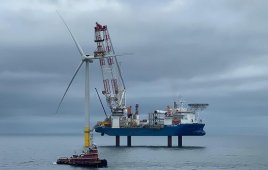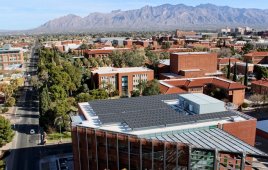Some say one technology for generating renewable power should be preferred over another because that one results in more jobs than another. To find out if that idea holds water, a team at PacifiCorp, a rate-regulated utility serving six western states, examined several generation methods. The team analyzed data to determine the labor intensity to operate different types of power generation. Based on the number of ongoing sustainable jobs required at PacifiCorp to operate different types of power generation, it appears that coal and nuclear power generation are more labor intensive than renewable energy methods. In fact, coal and nuclear power plants require about six times the number of jobs as wind. The labor intensity of natural gas-fueled power plants, along with gas extraction and pipeline transportation jobs, is more than twice the intensity of wind power. According to a study by the Electric Power Research Institute, wind power requires about double the operating and maintenance labor intensity of solar power. Compared to wind and solar, renewable geothermal steam is an exception discussed below.
The expectation that one type of energy resource has a higher degree of labor intensity than another—and is therefore preferred above other technologies solely on that basis—might not lead to wise public policy decisions. This is particularly relevant for a capital intensive industry like power generation. Jobs associated with a particular technology are an important consideration. Yet, the broader policy perspective warrants a look at the multitude of factors associated with generating resources such as cost, emissions, and plant availability. If a certain energy resource option produces lots of jobs, yet it is markedly more expensive than other carbon-free or low-carbon energy options, focusing solely on the jobs factor may result in policy decisions that are expensive for the many industries, businesses, and households that consume electric energy. Poor policy and needlessly expensive energy are like a tax on the economy. Taxes tend to dampen an economy and result in job losses across the landscape.
Despite the experience, a study prepared for the American Solar Energy Society says the U.S. can generate more than 4.5 million net jobs by 2030 if policymakers aggressively commit to programs that support energy efficiency and renewable energy. According to American Solar Energy Society and Management Information Services, Inc., this effort will result in a net savings to the U.S. economy. This is not a solitary view. President Obama plans to create 5 million new jobs by investing $150 billion over the next 10 years to catalyze private efforts to build a clean energy future. These figures compare with national employment of 140 million. Yet, neither of these opinions are couched in context with the number of jobs related to coal, natural gas, nuclear, and hydro-power generation.
Looking further at power generation jobs, the United States Bureau of Labor Statistics reported that in 2008, electric utility employment across the nation was 404,700.5 This represents both power generation and power line operations. Power generation jobs are probably less than half of utility jobs. Less than half of employees at PacifiCorp work directly and indirectly in power generation. Electric utility industry employment today accounts for less than 0.3% of the U.S. workforce.
Employment at power plants can be substantial, yet certain technologies result in even more jobs beyond the power-plant fence. Based on data published by the Energy Information Administration, the number of mining jobs related to coal-fueled power plants exceeds power plant employment. The coal mining industry employs more than 86,000 people versus a little more than 61,000 coal power generation jobs. This means that when mining operations are considered coal generating plants employ not 19 people/100 MW, but 44 people. Also, most coal is transported by rail, barge or truck. Coal transportation typically employs about 9 people per 100 MW.
Company data shows that 5 people are employed per 100 megawatts of natural gas-fired power generation. Natural gas extraction and pipeline transportation employ more jobs than do power plant operations. Based on data published by America’s Natural Gas Alliance, 10 extraction and pipeline activities employ 16 people to fuel 100 MW of a combined cycle power plant. The combined employment related to power plant operations, gas extraction and pipeline transportation is 21 people/100 MW.
The data indicates high labor intensity per MW of geothermal generation. PacifiCorp data is consistent with other geothermal operations. However, it is relevant to recognize that small power projects (most geothermal plants are small) typically have significantly higher labor intensity than large projects. To illustrate, the labor intensity at the 172 MW Carbon coal-fueled plant is more than double the labor intensity of the larger 2,117 MW Bridger coal-fueled plant. Most geothermal projects, including PacifiCorp’s Blundell geothermal plant, are sized at less than 50 MW. So it is not unexpected that the labor intensity of small geothermal projects might be higher than large steam-power operations.
Obviously there are jobs related to manufacturing power systems. Even if an unbiased report were available, it does not seem evident that there is a material labor intensity difference between manufacturing wind turbines and steam turbines. Further, it is not apparent that all manufacturing jobs are technology specific. Metallurgy, machinist, and many other manufacturing skills are similar when producing a wind turbine or a steam turbine.
Looking at construction, it appears that construction labor of a combined cycle natural gas plant is likely similar to the construction-labor intensity of renewable wind power projects, when equivalent time periods are taken into account.
Based on the number of ongoing sustainable jobs at PacifiCorp needed to build and to operate different types of power generation, it appears that renewable energy is likely more labor-efficient than steam-power generation. There are reasons to believe the opposite appears more likely.
Regardless of the number of jobs related to power production technologies, new cost-effective resources of all varieties should be pursued. Based on the current political climate and production costs, both natural gas and wind technologies seem to be cost effective compared to other resource options. Together these two technologies achieve a reasonable balance of costs and benefits. Despite differing labor intensities among technologies it is important to recognize that a discussion on relative job intensity is only a partial perspective. WPE
-Craig Johnson Senior Consultant, Pacific Corp
Filed Under: Policy






I feel so much happier now I unsdretand all this. Thanks!